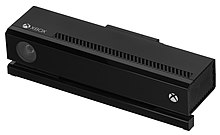
Back كنيكت Arabic Kinect Catalan Kinect German Kinect Greek Kinect Spanish Kinect Estonian Kinect Basque کینکت Persian Kinect Finnish Kinect French
 Kinect for Xbox One | |
| Developer | Microsoft |
|---|---|
| Type | Motion controller |
| Generation | Seventh and eighth |
| Release date | Xbox 360
Microsoft Windows
|
| Lifespan | 2010–2017 |
| Discontinued | Microsoft Windows
|
| Units sold | 35 million (as of October 25, 2017)[10] |
| Camera | 640×480 pixels @ 30 Hz (RGB camera) 640×480 pixels @ 30 Hz (IR depth-finding camera)[11] |
| Connectivity | USB 2.0 (type-A for original model; proprietary for Xbox 360 S) |
| Platform | Xbox 360 Xbox One Microsoft Windows (Windows 7 onwards) |
| Predecessor | Xbox Live Vision |
| Successor | Azure Kinect |
Kinect is a discontinued line of motion sensing input devices produced by Microsoft and first released in 2010. The devices generally contain RGB cameras, and infrared projectors and detectors that map depth through either structured light or time of flight calculations, which can in turn be used to perform real-time gesture recognition and body skeletal detection, among other capabilities. They also contain microphones that can be used for speech recognition and voice control.
Kinect was originally developed as a motion controller peripheral for Xbox video game consoles, distinguished from competitors (such as Nintendo's Wii Remote and Sony's PlayStation Move) by not requiring physical controllers. The first-generation Kinect was based on technology from Israeli company PrimeSense, and unveiled at E3 2009 as a peripheral for Xbox 360 codenamed "Project Natal". It was first released on November 4, 2010, and would go on to sell eight million units in its first 60 days of availability. The majority of the games developed for Kinect were casual, family-oriented titles, which helped to attract new audiences to Xbox 360, but did not result in wide adoption by the console's existing, overall userbase.
As part of the 2013 unveiling of Xbox 360's successor, Xbox One, Microsoft unveiled a second-generation version of Kinect with improved tracking capabilities. Microsoft also announced that Kinect would be a required component of the console, and that it would not function unless the peripheral is connected. The requirement proved controversial among users and critics due to privacy concerns, prompting Microsoft to backtrack on the decision. However, Microsoft still bundled the new Kinect with Xbox One consoles upon their launch in November 2013. A market for Kinect-based games still did not emerge after the Xbox One's launch; Microsoft would later offer Xbox One hardware bundles without Kinect included, and later revisions of the console removed the dedicated ports used to connect it (requiring a powered USB adapter instead). Microsoft ended production of Kinect for Xbox One in October 2017.
Kinect has also been used as part of non-game applications in academic and commercial environments, as it was cheaper and more robust than other depth-sensing technologies at the time. While Microsoft initially objected to such applications, it later released software development kits (SDKs) for the development of Microsoft Windows applications that use Kinect. In 2020, Microsoft released Azure Kinect as a continuation of the technology integrated with the Microsoft Azure cloud computing platform. Part of the Kinect technology was also used within Microsoft's HoloLens project. Microsoft discontinued the Azure Kinect developer kits in October 2023.[12][13]
- ^ Cite error: The named reference
EU launch datewas invoked but never defined (see the help page). - ^ Cite error: The named reference
releasedatewas invoked but never defined (see the help page). - ^ "Ya llegaron a Colombia los videojuegos que no necesitan controles" [They've arrived in Colombia: controller-free video games] (in Spanish). Caracol TV. November 14, 2010. Archived from the original on July 27, 2011. Retrieved November 14, 2010.
- ^ Cite error: The named reference
Xbox Kinect Australian launch datewas invoked but never defined (see the help page). - ^ "Microsoft to launch Kinect in Japan in November". The Economic Times. September 8, 2010. Archived from the original on January 14, 2012. Retrieved October 20, 2010.
- ^ "Starting February 1, 2012: Use the Power of Kinect for Windows to Change the World - Kinect for Windows Blog - Site Home - MSDN Blogs". Blogs.msdn.com. January 9, 2012. Archived from the original on March 11, 2012. Retrieved March 12, 2012.
- ^ "Microsoft isn't selling Kinect for Windows anymore". Engadget. April 3, 2015. Archived from the original on December 2, 2017. Retrieved December 1, 2017.
- ^ "Achievement Unlocked: 10 Years – Thank You, Xbox 360". Xbox Wire. April 20, 2016. Archived from the original on February 16, 2017. Retrieved July 4, 2016.
- ^ Cite error: The named reference
eg kinect eolwas invoked but never defined (see the help page). - ^ Reisinger, Don (October 25, 2017). "Microsoft Has Finally Killed the Kinect Xbox Sensor". Fortune. Archived from the original on December 2, 2017. Retrieved December 1, 2017.
- ^ Microsoft (2012). "Kinect for Windows SDK 1.6 Programming Guide". Microsoft. Archived from the original on March 13, 2013. Retrieved February 16, 2013.
- ^ "Microsoft's Azure Kinect Developer Kit Technology Transfers to Partner Ecosystem". TECHCOMMUNITY.MICROSOFT.COM. Retrieved November 10, 2023.
- ^ Peters, Jay (August 21, 2023). "Microsoft kills Kinect again". The Verge. Retrieved November 10, 2023.